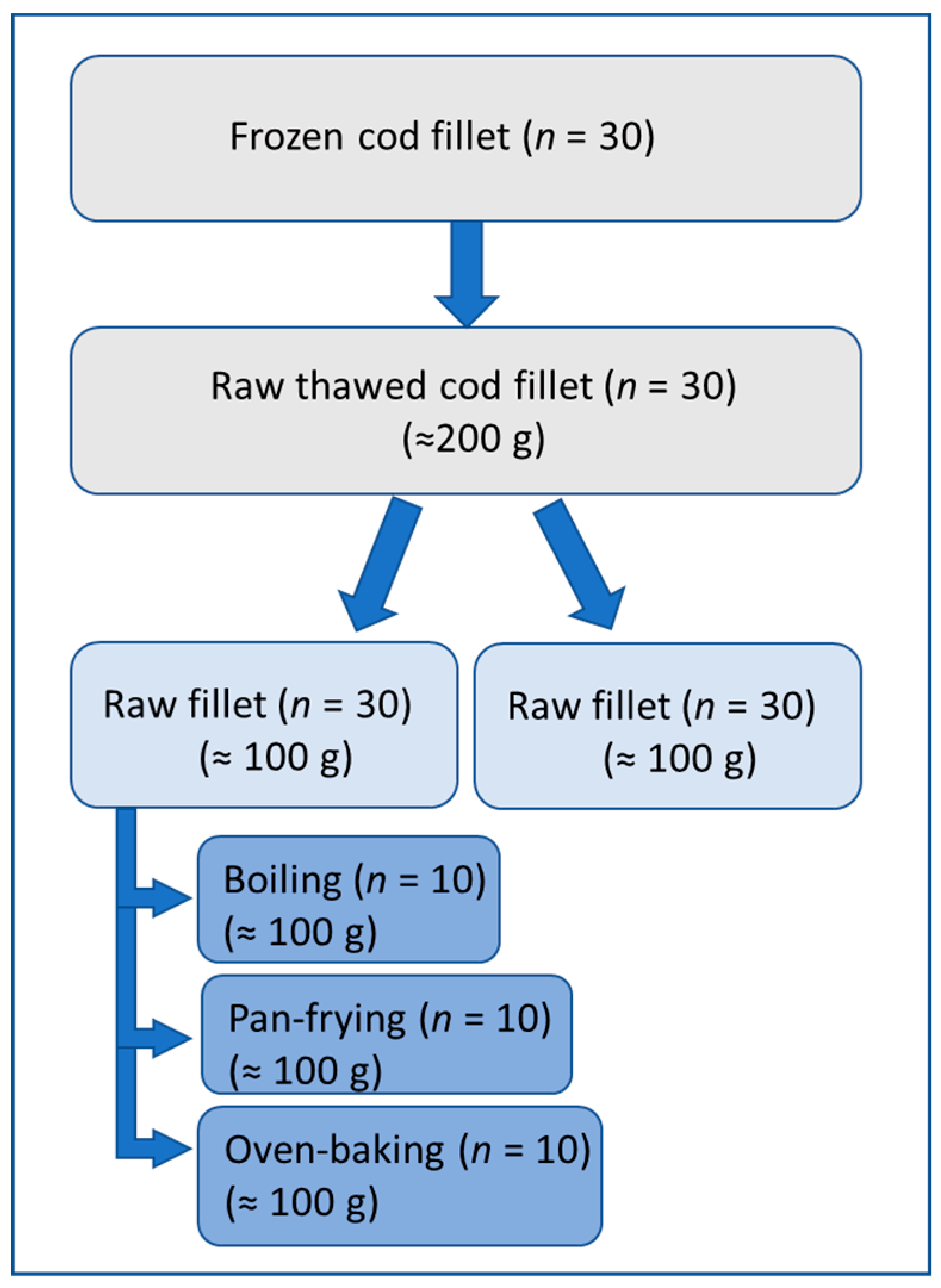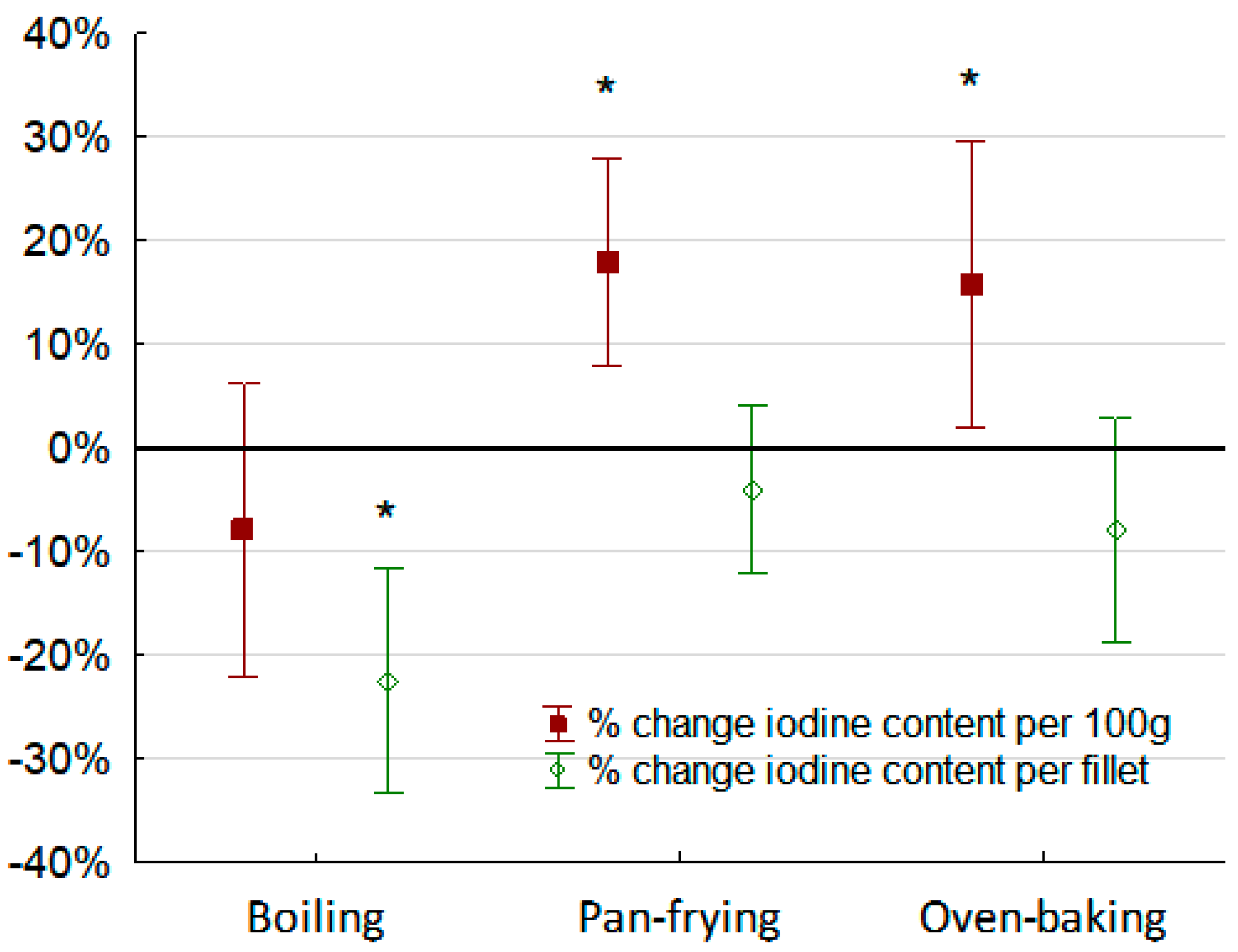Iodine and Mercury Content in Raw, Boiled, Pan-Fried, and Oven-Baked Atlantic Cod (Gadus morhua)
Abstract
1. Introduction
2. Materials and Methods
2.1. Fish Samples
2.2. Practical Procedure and Sample Preparation
2.3. Determination of Iodine
2.4. Determination of Mercury
2.5. Data Analysis and Statistical Methods
3. Results
3.1. Total Iodine and Mercury Content in Raw Cod Slices after Thawing
3.2. Dry Weight and Weight of the Cod Fillets before and after Different Cooking Methods
3.3. Iodine and Mercury Content per Cod Fillet and Content per 100 g before and after Different Cooking Methods
4. Discussion
5. Conclusions
Author Contributions
Funding
Acknowledgments
Conflicts of Interest
Abbreviations
| CRM | Certified Reference Material |
| DMA-80 | Direct Mercury Analyzer |
| FCDB | Food Composition Databases |
| FCT | Food Composition Tables |
| ICP-MS | Inductively Coupled Plasma-Mass Spectrometry |
| IMR | Institute of Marine Research |
| INFOODS | International Network of Food Data Systems |
| LOD | Limit of Detection |
| LOQ | Limit of Quantification |
| TMAH | Tetrametylammounium Hydroxid |
References
- Castanheira, I.; Saraiva, M.; Rego, A.; Ollilainen, V. EuroFIR guidelines for assessment of methods of analysis: GAMA. Food Chem. 2016, 193, 82–89. [Google Scholar] [CrossRef] [PubMed]
- Erkan, N. Iodine content of cooked and processed fish in Turkey. Int. J. Food Sci. Technol. 2011, 46, 1734–1738. [Google Scholar] [CrossRef]
- Norwegian Food Composition Table. Available online: https://www.matvaretabellen.no/?language=en (accessed on 10 November 2020).
- International Network of Food Data Systems (INFOODS). Available online: http://www.fao.org/infoods/infoods/tables-and-databases/faoinfoods-databases/en/ (accessed on 10 November 2020).
- Food and Agriculture Organization of the United Nations. FAO/INFOODS Global Food Composition Database for Fish and Shellfish Version 1.0 - uFiSh1.0. 2006. Available online: http://www.fao.org/3/a-i6655e.pdf (accessed on 10 November 2020).
- Institute of Marine Research. Seafood data. Available online: https://sjomatdata.hi.no/#search/ (accessed on 10 November 2020).
- Ølmheim, O. Economic and Biological Figures from NORWEGIAN Fisheries—2019; Directorate of Fisheries: Bergen, Norway, 2020; 38p. [Google Scholar]
- Julshamn, K.; Dahl, L.; Eckhoff, K. Determination of Iodine in Seafood by Inductively Coupled Plasma/Mass Spectrometry. J. AOAC Int. 2001, 84, 1976–1983. [Google Scholar] [CrossRef] [PubMed]
- Nerhus, I.; Markhus, M.W.; Nilsen, B.M.; Øyen, J.; Maage, A.; Ødegård, E.R.; Midtbø, L.K.; Frantzen, S.; Kögel, T.; Graff, I.E.; et al. Iodine content of six fish species, Norwegian dairy products and hen’s egg. Food Nutr. Res. 2018, 62. [Google Scholar] [CrossRef]
- Zimmerman, M.B.; Boelaert, K. Iodine deficiency and thyroid disorders. Lancet Diabetes Endocrinol. 2015, 3, 286–295. [Google Scholar] [CrossRef]
- NNR. Nordic Nutrition Recommendation 2012 Integrating Nutrition and Physical Activity, 5th ed.; Nordic Council of Ministers: Copenhagen, Denmark, 2014; Available online: https://norden.diva-portal.org/smash/get/diva2:704251/FULLTEXT01.pdf (accessed on 2 October 2020).
- Bradley, M.A.; Barst, B.D.; Basu, N. A Review of Mercury Bioavailability in Humans and Fish. Int. J. Environ. Res. Public Health 2017, 14, 169. [Google Scholar] [CrossRef]
- Azad, A.M.; Frantzen, S.; Bank, M.S.; Nilsen, B.M.; Duinker, A.; Madsen, L.; Maage, A. Effects of geography and species variation on selenium and mercury molar ratios in Northeast Atlantic marine fish communities. Sci. Total. Environ. 2019, 652, 1482–1496. [Google Scholar] [CrossRef]
- Sheehan, M.C.; A Burke, T.; Navas-Acien, A.; Breysse, P.N.; Mcgready, J.; A Fox, M. Global methylmercury exposure from seafood consumption and risk of developmental neurotoxicity: A systematic review. Bull. World Health Organ. 2014, 92, 254F–269F. [Google Scholar] [CrossRef]
- Julshamn, K.; Duinker, A.; Nilsen, B.M.; Nedreaas, K.; Maage, A. A baseline study of metals in cod (Gadus morhua) from the North Sea and coastal Norwegian waters, with focus on mercury, arsenic, cadmium and lead. Mar. Pollut. Bull. 2013, 72, 264–273. [Google Scholar] [CrossRef]
- Nerhus, I.; Odland, M.; Kjellevold, M.; Midtbø, L.K.; Markhus, M.W.; Graff, I.E.; Lie, Ø.; Kvestad, I.; Frøyland, L.; Dahl, L.; et al. Iodine status in Norwegian preschool children and associations with dietary iodine sources: The FINS-KIDS study. Eur. J. Nutr. 2019, 58, 2219–2227. [Google Scholar] [CrossRef]
- Aakre, I.; Næss, S.; Kjellevold, M.; Markhus, M.W.; Alvheim, A.R.; Dalane, J.Ø.; Kielland, E.; Dahl, L. New data on nutrient composition in large selection of commercially available seafood products and its impact on micronutrient intake. Food Nutr. Res. 2019, 63. [Google Scholar] [CrossRef] [PubMed]
- Næss, S.; Aakre, I.; Lundebye, A.-K.; Ørnsrud, R.; Kjellevold, M.; Markhus, M.W.; Dahl, L. Mercury, lead, arsenic, and cadmium in Norwegian seafood products and consumer exposure. Food Addit. Contam. Part B 2020, 13, 99–106. [Google Scholar] [CrossRef]
- Markhus, M.W.; Kvestad, I.; Midtbø, L.K.; Nerhus, I.; Ødegaard, E.R.; Graff, I.E.; Lie, Ø.; Dahl, L.; Hysing, M.; Kjellevold, M. Effects of cod intake in pregnancy on iodine nutrition and infant development: Study protocol for Mommy’s Food—a randomized controlled trial. BMC Nutr. 2018, 4, 7–8. [Google Scholar] [CrossRef] [PubMed]
- U.S. EPA. EPA Method 7473 (SW-846): Mercury in Solids and Solutions by Thermal Decomposition, Amalgamation, and Atomic Absorption Spectrophotometry. 1998. Available online: https://www.epa.gov/esam/epa-method-7473-sw-846-mercury-solids-and-solutions-thermal-decomposition-amalgamation-and (accessed on 10 November 2020).
- Alves, R.N.; Maulvault, A.L.; Barbosa, V.L.; Fernandez, M.; Tediosi, A.; Kotterman, M.; van der Heuvel, F.H.; Robbens, J.; Fernandes, J.; Rasmussen, R.R.; et al. Oral bioaccessibility of toxic and essential elements in raw and cooked commercial seafood species available in European markets. Food Chem. 2018, 267, 15–27. [Google Scholar] [CrossRef] [PubMed]
- Doh, H.; Lee, M.H.; Park, H.J. Effect of different cooking methods on the content and bioaccessibility of iodine components in abalone (Haliotis discus hannai). Food Chem. 2019, 301, 125197. [Google Scholar] [CrossRef] [PubMed]
- Goindi, G.; Karmarkar, M.G.; Kapil, U.; Jagannathan, J. Estimation of losses of iodine during different cooking procedures. Asia Pac. J. Clin. Nutr. 1995, 4, 225–227. [Google Scholar] [PubMed]
- Longvah, T.; Toteja, G.; Upadhyay, A. Iodine content in bread, milk and the retention of inherent iodine in commonly used Indian recipes. Food Chem. 2013, 136, 384–388. [Google Scholar] [CrossRef]
- Meinhardt, A.-K.; Müller, A.; Burcza, A.; Greiner, R. Influence of cooking on the iodine content in potatoes, pasta and rice using iodized salt. Food Chem. 2019, 301, 125293. [Google Scholar] [CrossRef]
- Rana, R.; Raghuvanshi, R.S. Effect of different cooking methods on iodine losses. J. Food Sci. Technol. 2013, 50, 1212–1216. [Google Scholar] [CrossRef][Green Version]
- Morgan, J.N.; Berry, M.R.; Graves, R.L. Effects of commonly used cooking practices on total mercury concentration in fish and their impact on exposure assessments. J. Expo. Anal. Environ. Epidemiol. 1997, 7, 119–133. [Google Scholar]
- Perelló, G.; Martí-Cid, R.; Llobet, J.M.; Domingo, J.L. Effects of Various Cooking Processes on the Concentrations of Arsenic, Cadmium, Mercury, and Lead in Foods. J. Agric. Food Chem. 2008, 56, 11262–11269. [Google Scholar] [CrossRef] [PubMed]
- Ouédraogo, O.; Amyot, M. Effects of various cooking methods and food components on bioaccessibility of mercury from fish. Environ. Res. 2011, 111, 1064–1069. [Google Scholar] [CrossRef] [PubMed]


| Sample | Iodine/Raw Fillet * (µg) | Iodine Thawing Water (µg) | Iodine Loss after Thawing (%) | Mercury/Raw Fillet (µg) |
|---|---|---|---|---|
| Cod fillet (#1–10) | 101.4 ± 146.4 | 13.0 ± 19.6 | 12.3 ± 1.9 | 2.7 ± 1.3 |
| (53.0) | (6.0) | (12.2) | (2.3) | |
| Cod fillet (#11–20) | 59.7 ± 32.7 | 7.2 ± 4.3 | 12.2 ± 3.1 | 3.0 ± 1.8 |
| (50.0) | (6.7) | (13.3) | (2.4) | |
| Cod fillet (#21–30) | 54.7 ± 15.5 | 5.2 ± 1.8 | 10.2 ± 4.6 | 2.1 ± 0.8 |
| (53.4) | (4.8) | (8.9) | (2.0) | |
| All (n = 30) | 71.9 ± 86.7 | 8.5 ± 11.7 | 11.6 ± 3.4 | 2.6 ± 1.4 |
| (52.0) | (5.4) | (11.7) | (2.2) |
| Cooking Method | Dry Weight before (%) | Dry Weight after (%) | Weight before (g) | Weight after (g) | Weight Change (%) |
|---|---|---|---|---|---|
| Boiling (n = 10) | 18.9 ± 0.6 a | 21.0 ± 0.7 b | 99.6 ± 7.4 a | 84.2 ± 7.5 b | 15.5 ± 3.5 |
| (19.0) | (20.7) | (99.8) | (84.5) | (16.6) | |
| Pan-frying (n = 10) | 19.0 ± 0.5 a | 25.6 ± 0.9 b | 100.7 ± 7.1 a | 82.1 ± 7.4 b | 18.6 ± 1.9 |
| (19.0) | (25.7) | (100.8) | (81.6) | (18.0) | |
| Oven-baking (n = 10) | 19.5 ± 0.6 a | 23.2 ± 0.5 b | 103.6 ± 7.3 a | 82.5 ± 7.4 b | 20.4 ± 2.4 |
| (19.4) | (23.2) | (100.2) | (81.8) | (20.0) | |
| All (n = 30) | 19.1 ± 0.6 | 23.3 ± 2.0 | 101.3 ± 7.2 | 82.9 ± 7.2 | 18.2 ± 3.3 |
| (19.0) | (23.2) | (101.2) | (20.0) | (18.6) |
| Cooking Method | Iodine/Fillet, before * (µg) | Iodine/Fillet, after ** (µg) | Iodine Liquid *** (µg) | Iodine Content before (µg/100 g) | Iodine Content after (µg/100 g) |
|---|---|---|---|---|---|
| Boiling (n = 10) | 114.6 ± 175.1 a | 79.4 ± 101.9 b | 32.5 ± 43.4 | 116.9 ± 182 a | 97.6 ± 130.8 a |
| (55.3) | (40.5) | (14.8) | (56) | (44.5) | |
| Pan-frying (n = 10) | 65.9 ± 29.1 | 63.9 ± 30.4 | 1.3 ± 0.5 | 66.7 ± 33.8 a | 79.5 ± 43.9 b |
| (56.2) | (49.5) | (1.2) | (57) | (62.5) | |
| Oven-baking (n = 10) | 61.6 ± 18.1 | 55.7 ± 15.4 | 9.3 ± 3.4 | 59.1 ± 15.6 a | 67.2 ± 16.4 b |
| (62.4) | (57) | (16.6) | (60.5) | (70) | |
| All (n = 30) | 80.7 ± 102.4 | 66.3 ± 60.7 | 14.4 ± 27.8 | 80.9 ± 106.7 | 81.4 ± 78.5 |
| (57.6) | (49.4) | (9.6) | (56.5) | (62.5) |
| Cooking Method | Mercury/Fillet, before (µg) | Mercury/Fillet, after (µg) | Mercury Content before (µg/100 g) | Mercury Content after (µg/100 g) |
|---|---|---|---|---|
| Boiling (n = 10) | 2.9 ± 1.6 | 2.7 ± 1.4 | 2.9 ± 1.3 | 3.2 ± 1.5 |
| (2.5) | (2.4) | (2.5) | (2.8) | |
| Pan-frying (n = 10) | 3.3 ± 1.9 | 3.5 ± 1.9 | 3.3 ± 1.8 | 4.3 ± 2.2 |
| (2.7) | (3.1) | (2.7) | (3.6) | |
| Oven-baking (n = 10) | 2.4 ± 0.8 | 2.2 ± 0.8 | 2.3 ± 0.8 | 2.7 ± 1.0 |
| (2.1) | (2.0) | (2.1) | (2.5) | |
| All (n = 30) | 2.9 ± 1.5 | 2.8 ± 1.5 | 2.8 ± 1.4 | 3.4 ± 1.7 |
| (2.4) | (2.3) | (2.4) | (2.8) |
Publisher’s Note: MDPI stays neutral with regard to jurisdictional claims in published maps and institutional affiliations. |
© 2020 by the authors. Licensee MDPI, Basel, Switzerland. This article is an open access article distributed under the terms and conditions of the Creative Commons Attribution (CC BY) license (http://creativecommons.org/licenses/by/4.0/).
Share and Cite
Dahl, L.; Duinker, A.; Næss, S.; Markhus, M.W.; Nerhus, I.; Midtbø, L.K.; Kjellevold, M. Iodine and Mercury Content in Raw, Boiled, Pan-Fried, and Oven-Baked Atlantic Cod (Gadus morhua). Foods 2020, 9, 1652. https://doi.org/10.3390/foods9111652
Dahl L, Duinker A, Næss S, Markhus MW, Nerhus I, Midtbø LK, Kjellevold M. Iodine and Mercury Content in Raw, Boiled, Pan-Fried, and Oven-Baked Atlantic Cod (Gadus morhua). Foods. 2020; 9(11):1652. https://doi.org/10.3390/foods9111652
Chicago/Turabian StyleDahl, Lisbeth, Arne Duinker, Synnøve Næss, Maria Wik Markhus, Ive Nerhus, Lisa Kolden Midtbø, and Marian Kjellevold. 2020. "Iodine and Mercury Content in Raw, Boiled, Pan-Fried, and Oven-Baked Atlantic Cod (Gadus morhua)" Foods 9, no. 11: 1652. https://doi.org/10.3390/foods9111652
APA StyleDahl, L., Duinker, A., Næss, S., Markhus, M. W., Nerhus, I., Midtbø, L. K., & Kjellevold, M. (2020). Iodine and Mercury Content in Raw, Boiled, Pan-Fried, and Oven-Baked Atlantic Cod (Gadus morhua). Foods, 9(11), 1652. https://doi.org/10.3390/foods9111652





